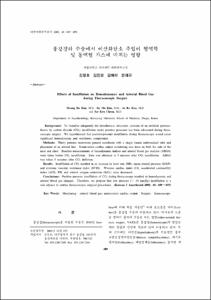KUMEL Repository
1. Journal Papers (연구논문)
1. School of Medicine (의과대학)
Dept. of Anesthesiology & Pain Medicine (마취통증의학)
흉강경하 수술에서 이산화탄소 주입이 혈역학 및 동맥혈 가스에 미치는 영향
- Keimyung Author(s)
- Kim, Jin Mo; Kim, Ae Ra; Cheun, Jae Kyu
- Journal Title
- 대한마취과학회지
- Issued Date
- 2001
- Volume
- 40
- Issue
- 4
- Abstract
- Background: To visualize adequately the intrathoracic structures, creation of an artificial pneumothorax by carbon dioxide (CO2) insufflation under positive pressures has been advocated during thoracoscopic surgery. We hypothesized that positive-pressure insufflation during thoracoscopy would cause significant hemodynamic and ventilatory compromise.
Methods: Thirty patients underwent general anesthesia with a single lumen endotracheal tube and placement of an arterial line. Noninvasive cardiac output monitoring was done on both the side of the neck and chest. Baseline measurements of hemodynamic indices and arterial blood gas analysis (ABGA) were taken before CO2 insufflation. Data was obtained at 5 minutes after CO2 insufflation. ABGA was taken 5 minutes after CO2 deflation.
Results: Insufflation of CO2 resulted in an increase in heart rate (HR), mean arterial pressure (MAP), and systemic vascular resistance index (SVRI). Whereas cardiac index (CI), accelerated contractility index (ACI), PH, and arterial oxygen saturation (SaO2) were decreased.
Conclusions: Positive pressure insufflation of CO2 during thoracoscopy resulted in hemodynamic and arterial blood gas changes. Therefore, we propose that low pressure (< 10 mmHg) insufflation is a safe adjunct to routine thoracoscopic surgical procedures. (Korean J Anesthesiol 2001; 40: 489∼495)
Key word : Monitoring: arterial blood gas; noninvasive cardiac output. Surgery: thoracoscopy.
- Alternative Title
- Effects of Insufflation on Hemodynamics and Arterial Blood Gas during Thoracoscopic Surgery
- Publisher
- School of Medicine
- Citation
- 김명호 et al. (2001). 흉강경하 수술에서 이산화탄소 주입이 혈역학 및 동맥혈 가스에 미치는 영향. 대한마취과학회지, 40(4), 489–495. doi: 10.4097/kjae.2001.40.4.489
- Type
- Article
- ISSN
- 0302-5780
- Appears in Collections:
- 1. School of Medicine (의과대학) > Dept. of Anesthesiology & Pain Medicine (마취통증의학)
- 파일 목록
-
-
Download
 oak-bbb-878.pdf
기타 데이터 / 210.22 kB / Adobe PDF
oak-bbb-878.pdf
기타 데이터 / 210.22 kB / Adobe PDF
-
Items in Repository are protected by copyright, with all rights reserved, unless otherwise indicated.